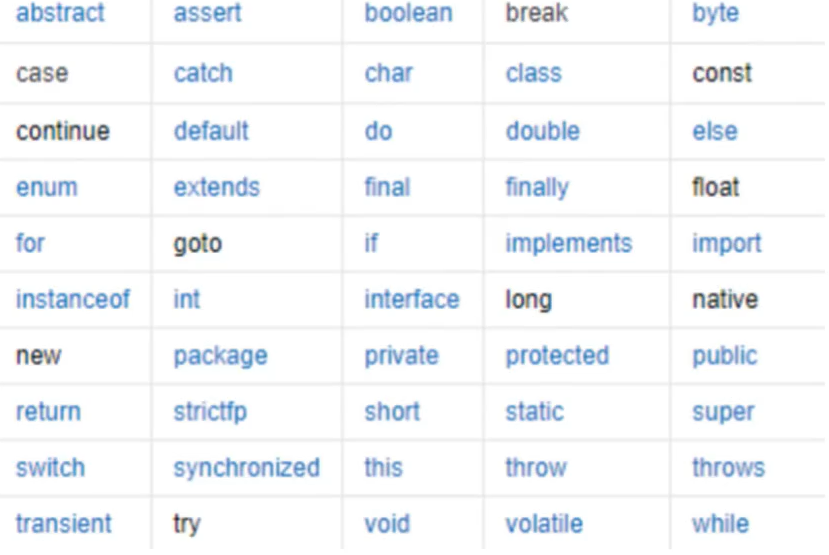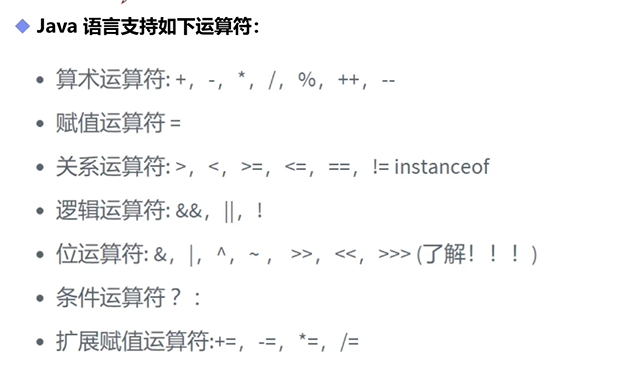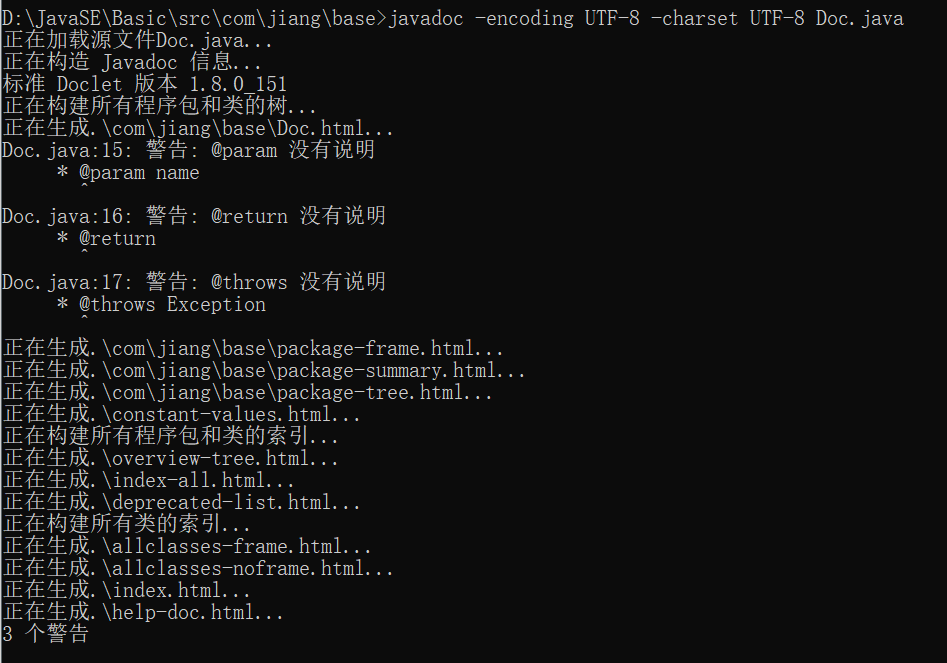Java基础语法
注释
注释并不会被执行,只是给人看的
Java中的注释有三种:
- 单行注释 //
- 多行注释 /* */
- 文档注释/** */
标识符
- 关键字

- 标识符注意点
- 所有的标识符都应该以字母(A-Z或者a-z)、美元符($)、或者下划线(_)开始
- 首字符后可以是字母(A-Z或者a-z)、美元符($)、或者下划线(_)或数字的任何字符组合
- 不能使用关键字作为变量名或方法名
- 标识符是大小写敏感的
数据类型
补充内容:
什么是字节?
-
位(bit):是计算机内部数据存储的最小单位
-
字节(byte):是计算机中数据处理的基本单位,习惯上用大写B来表示
-
1B (byte,字节) = 8 bit(位)
-
字符:是指计算机中使用的字母、数字、字和符号
1bit 表示1位 1 Byte 表示一个字节 1B = 8 b 1024B = 1KB 1024KB = 1M 1024M = 1G -
强类型语言
- 要求变量的使用严格符合规定,所有变量都必须先定义后才能使用
-
弱类型语言
-
Java的数据类型分为两大类
-
基本类型(primtive type)
-
数值类型
-
整数类型
byte占1个字节范围:-128~127
short 2字节
int 4字节
long 8字节
-
浮点类型
float 4字节
double 8字节
-
字符类型
char 2字节
-
-
boolean类型
占1位其值只有true和false两个
-
-
引用类型(reference type)
- 类
- 接口
- 数组
-
public class HelloWorld {
public static void main(String[] args) {
//八大基本数据类型
//整数
int num1 = 10; //最常用
byte num2 = 20;
short num3 = 30;
long num4 = 30L;//Long类型要在数字后面加个L
Byte
//小数:浮点数
float num5 = 50.1F;
double num6 = 3.141592653589793238462643;
//字符
char nmae = 'A';
//字符串,String不是关键字,类
String name = '姜新羽';
//布尔值
boolean flag = true;
// boolean flag = false;
}
}
面试题补充
public class HelloWorld {
public static void main(String[] args) {
//整数拓展: 进制 二进制0b 十进制 八进制0 十六进制0x
int i = 10;
int i2 = 010;//八进制0
int i3 = 0x10;//十六进制0x 0~9 A~F 16
System.out.println(i);
System.out.println(i2);
System.out.println(i3);
System.out.println("===============================");
//==================================================
//浮点数拓展? 银行业务怎么表示? 钱
//BigDecimal
//==================================================
//float 有限 离散 舍入误差 大约 接近但不等于
//double
//最好避免使用浮点数进行比较
//最好避免使用浮点数进行比较
//最好避免使用浮点数进行比较
float f = 0.1f; // 0.1
double d = 1.0/10;//0.1
System.out.println(f==d);//false
float d1 = 2313131223f;
float d2 = d1 + 1;
System.out.println(d1==d2);//ture
//==================================================
//字符拓展
//==================================================
char c1 = 'a';
char c2 = '中';
System.out.println(c1);
System.out.println((int)c1);//强制换行
System.out.println(c2);
System.out.println((int)c2);//强制换行
//所有的字符本质还是数字
//编码 Unicode 2字节 0-65536 Excel 2^16 = 65536
char c3 = '\u0061';//Unicode 的使用
System.out.println(c3);//a
//转义字符
// \t 制表符
// \n 换行
System.out.println("Hello\tWorld");
//对象,从内存分析
String sa = new String("hello world");
String sb = new String("hello world");
System.out.println(sa==sb); //false
String sc = "hello world";
String sd = "hello world";
System.out.println(sc==sd); //true
//布尔值扩展
boolean flag = true;
if (flag == true){}//新手
if (flag){}//老手
}
- 类型转换
public class HelloWorld {
public static void main(String[] args) {
int i = 128;
byte b = (byte) i;//内存溢出
//强制转换 (类型)变量名 高->低
//自动转换 低->高
System.out.println(i);
System.out.println(b);
/*
注意点:
1. 不能把布尔值进行转换
2. 不能把对象类型转换为不相干的类型
3. 在把高容量转换到低容量的时候,强制转换
4. 转换的时候可能存在内存溢出,或者精度问题!
*/
System.out.println("================");
char c = 'a';
int d = c+1;
System.out.println(d);
System.out.println((char)d);
//操作比较大的数的时候,注意一出问题
//JDK7新特性,数字之间可以用给下划线分割
int money = 10_0000_0000;
int years = 20;
int total = money*years;//-1474836480 ,计算的时候移除了
long total2 = money *years; //默认是int,转换前已经存在溢出了
System.out.println(total);
long total3 = money*((long)years);//先把一个数转换为long
System.out.println(total3);
//L l
}
}
-
变量
-
变量:可以变化的量!
-
Java是一种强类型语言,每个变量都必须声明其类型。
-
Java变量是程序中最基本的存储单元,其要素包括变量名,变量类型和作用域。
type varName [=value][{,varName[=value]}]; //数据类型 变量名 = 值; 可以使用逗号隔开来声明多个同类型变量 -
注意事项:
- 每个变量都有类型,类型可以是基本类型,也可以是引用类型。
- 变量名必须是合法的标识符。
- 变量声明是一条完整的语句,因此每一个声明都必须以分号结束。
-
变量的作用域
- 类变量
- 实例变量
- 局部变量
public class Variable{ static int allClinks = 0; //类变量 String str = "hello world";//实例变量 public void method(){ int i=0; //局部变量 } }
-
public class HelloWorld {
//类变量 static
static double salary = 2500;
//属性:变量
//实例变量:从属于对象; 如果不进行初始化,这个类型的默认值 0 0.0
//布尔值:默认为false
//除了基本类型,其余的默认值全是null;
String name;
int age;
//main 方法
public static void main(String[] args) {
//局部变量:必须声明和初始化值
int i=10;
System.out.println(i);
// 变量类型 变量名字 = new HelloWorld()
HelloWorld helloWorld = new HelloWorld();
System.out.println(helloWorld.age);
System.out.println(helloWorld.name);
//类变量 static
System.out.println(salary);
}
//其他方法
public void add(){
// System.out.println(i);
}
}
-
常量
-
Constant :初始化后不会再改变值
-
所谓常量可以理解为一种特殊的变量,它的值被设定后,再程序运行过程中不被允许改变。
//final 常量名=值; final double PI = 3.14; -
常量名一般使用大写字符。
public class HelloWorld { //修饰符,不存在先后顺序 // static final double PI = 3.14; final static double PI = 3.14; public static void main(String[] args) { System.out.println(PI); } } -
运算符

package operator;
public class Demo01 {
public static void main(String[] args) {
//二元运算符
//Ctrl +D :复制当前行到下一行
int a= 10;
int b = 20;
int c = 25;
int d = 25;
System.out.println(a+b);
System.out.println(a-b);
System.out.println(a*b);
System.out.println(a/(double)b);
}
}
package operator;
public class Demo02 {
public static void main(String[] args) {
long a = 12341545324563L;
int b = 123;
short c = 10;
byte d =8;
System.out.println(a+b+c+d);//Long
System.out.println(b+c+d);//Int
System.out.println(c+d);//Int
}
}
package operator;
public class Demo03 {
public static void main(String[] args) {
//关系运算符返回的结果:正确,错误 布尔值
int a = 10;
int b = 20;
int c = 21;
//取余,模运算
System.out.println(c%a);//c/a 21/10=2...1
System.out.println(a>b);
System.out.println(a<b);
System.out.println(a==b);
System.out.println(a!=b);
// false
// true
// false
// true
}
}
package operator;
public class Demo04 {
public static void main(String[] args) {
//++ -- 自增,自减 一元运算符
int a = 3;
int b = a++;
// a = a+1; //执行完这行代码后,先给b赋值,再自增
// a = a + 1;
int c = ++a; // 执行完这行代码前,先自增,再给c赋值
System.out.println(a);
System.out.println(b);
System.out.println(c);
// 幂运算 2^3 2*2*2 = 8 很多运算,我们会使用一些工具类来操作
double pow = Math.pow(2,3);
System.out.println(pow);
}
}
package operator;
//逻辑运算符
public class Demo05 {
public static void main(String[] args) {
// 与(and) 或(or) 非(取反)
boolean a = true;
boolean b = false;
System.out.println("a && b"+(a&&b)); //逻辑与运算:同真才true
System.out.println("a || b"+(a||b));//逻辑或运算:一真则true
System.out.println("!(a && b)"+!(a&&b));//真变假,假变真
//短路运算
int c = 5;
boolean d = (c<4)&&(c++<4);
System.out.println(d);
System.out.println(c);
}
}
package operator;
// 位运算符
public class Demo06 {
public static void main(String[] args) {
/*
A = 0011 1100
B = 0000 1101
A&B = 0000 1100
A|B = 0011 1101
A^B = 0011 0001
~B = 1111 0010
*/
/*
2*8 = 16 2*2*2*2 最快计算2*8 位运算
<<左移 *2
>>右移 /2
*/
System.out.println(2 << 3);
}
}
package operator;
public class Demo07 {
public static void main(String[] args) {
int a =10;
int b = 20;
a+=b;
System.out.println(a);
//字符串连接符 + ,String
System.out.println("" + a + b);
//3020 先连接了所以不运算
System.out.println(a + b + "");
//50 先运算再连接
}
}
package operator;
//三元运算符
public class Demo08 {
public static void main(String[] args) {
//x ? y : z
//如果 x == true,则结果为y,否则结果为z
int score = 80;
String type = score < 60 ? "不及格":"及格";//必须掌握
//if
System.out.println(type);
}
}
包机制
-
为了更好地组织类,Java提供了包机制,用于区别类名的命名空间。
-
包语句的语法格式为:
package pkg1[.pkg2[.pkg3...]]; -
一般利用公司域名倒置作为包名; com.zhang.xxx
com.wang.xxx
-
为了能使用某一个包的成员,我们需要在Java程序中明确导入该包。
import package1[.package2...].(classnmae|*)
JavaDoc
-
javadoc命令是用来生成自己的API文档的
-
参数信息
- @author 作者名
- @version 版本号
- @since 指明需要最早使用的jdk版本
- @param 参数名
- @return 返回值情况
- @throws 异常抛出情况
package com.jiang.base; /** * @author jiangxinyu * @version 1.0 * @since 1.8 * */ public class Doc { String name; /** * * @param name * @return * @throws Exception */ public String test(String name) throws Exception{ return name; } } -
命令行生成

-
IDEA生成



 浙公网安备 33010602011771号
浙公网安备 33010602011771号